| printer friendly | |||
|
|||
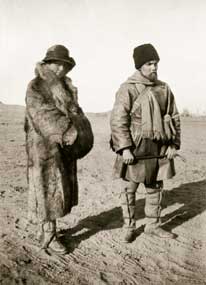 | |
| H. and G. Roerichs during
the Central-Asian expedition. 1925-1927 |
The expedition passed 25 thousand kilometers. It crossed two deserts. It overcame 35 mountain passes, many of which were for the first time marked on the map by the travelers. Enormous scientific material was collected. And this material was selected and comprehended by N. Roerich from a broad philosophic point of view. And this circumstance determined the scientific uniqueness of the Central-Asian expedition.
During the travel, N. Roerich created more than 500 paintings, sketches, drawings. There has been no expedition which would be so wonderfully reflected in paintings like the Central-Asian one. Roerich studied the world of the past and present with the thought of a scientist and foreseeing imagination of an artist. Combining legends with the real facts, in his paintings and expedition diaries, the artist marked the greatest for our time and our planet landmarks of the cosmic evolution of mankind.
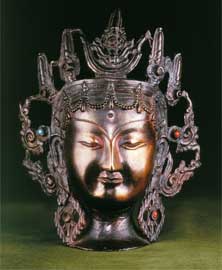 | |
| Buddha Maytreya |
The expedition itinerary went through the lands of the most ancient cultures of Asia. Nicholas Roerich “looked for what unites various peoples and cultures, and not separates them, L. Shaposhnikova points out. – Ancient unity, having passed through separation, must <…> result in a higher unity in the future. Each culture will contribute into this unity its unique gifts. Diversity of colors, forms, its way of thinking and perception of the surrounding world. The richness of its spirit. He did not determine the time of this future. But in the past and the present which he observed, he searched for this future”41.
“Because the past and the future not only do not exclude each other, but on the contrary, they are just mutually strengthening, the artist wrote. – How not appreciate and admire the achievements of ancient cultures! The wonderful stones have preserved the wonderful hieroglyph, always applicable, as the Truth itself is always applicable”42.
He emphasized those important, intransient things which do not disappear with time, but become a connecting bridge between the past, the present, and the future. At the basis of such intransient essences, lay collective creative work of peoples, ancient and modern, their cultural and moral experience, their spiritual values and accumulations resulting from their labor – those things that make the “wonderful stones” of the human culture.
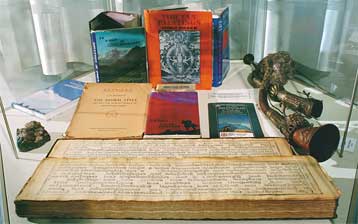 | |
| Show-case fragment |
Noting the common aspects in the cultures of Russia and India, studying the cultures of ancient Asian countries, Roerich came to the conclusion that there is more resemblance in cultures of different peoples that differences. This resemblance united the countries of Asia with Europe and America. “And our optimism, the artist pointed out, is not the product of reverie, but the result of study of a dozen of countries and of wide approaches towards various peoples with absolutely different psychologies. And, in the long run, despite all the differences, they are the same. And the language of the heart, the language of love is the same.
If the sign of malice is minus, sharp like a piercing arrow, the sign of love is plus, an eternal glowing cross which, from the times immemorial, poured light on consciousness and contributed to the uprising of life”43.
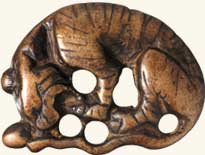 | |
| “Beast style”. An object
from the Roerich family collection |
The fates of the East and the West have interwoven for many thousands of years of the human history. Nomad tribes contributed to active cultural interaction of the West and the East. The traces of early nomads were found by the expedition in the Himalayas, in Gobi desert, in Mongolia, on Altai. Unlike many scientists of that time who considered nomads inert and negatively affecting the course of the world history, Nicholas and George Roerichs pointed out their extremely important role in this history. It was them who made the basis for the first large national formations and influenced in a most decisive way various peoples’ ethnogeny. They created their unique culture, making part of the world culture. Their art contained new unusual forms and got the name of “beast style”.
The Roerichs were the first scientists who discovered the “beast style” in Tibet. Collections of “beast style” objects found by the expedition in that region is exhibited in the hall show-case.
Nicholas Roerich believed that mobility of peoples, same as changeability of the surface of the planet itself, is governed by unified cosmic laws. From the very ancient times, waves of settlers rolled along the ancient ways of the planet. The traces of those migrations were marked with petroglyphs, mysterious megaliths, ancient burial places. The artist called them the Signs of Great Wanderers. On the rocks of Altai, Mongolia, Ladakh, Chinese Turkistan, tough-horned mountain goats, archers, dancing figures were carved. Roerich had seen the same petroglyphs in Scandinavia, Hungary, America.
Discovery of ancient menhirs in Tibet led him to Europe. “When they asked me: “Why are you so happy to see these menhirs?” – I answered: “Because my map of fairy-tales has got confirmation. When you are holding in one hand the end of a magic thread in Karnak, is it not happiness to discover its beginning in Trans-Himalayas?”44 “The map of fairy-tales” – this is how he called supposed by him itinerary of peoples’ movements.
Roerich was convinced that the culture of both the worlds had a common ancient source, and this source was in the East. “<…> it is the highlands of the Himalayas and Trans-Himalayas that were one of the main destinations of the peoples’ migration <…>”45.
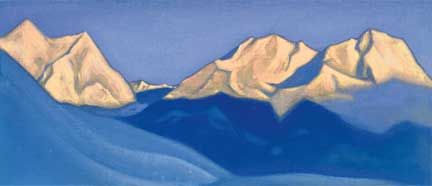 | |
| N. Roerich. Himalayas (Pink Tops). 1947 |
Not separation, but unification. Not opposition, but harmonious merge. “The idea of the East and the West, Nicholas Roerich wrote, – the idea of twins who will never meet, is already an inveterate idea for our mind <…> The West can easily understand the main, fundamental ideas of the East, and preserve the eternal wisdom initiated in that part of the world where all religions and beliefs in fact originated. And the great East follows the discoveries of the West and appreciates the achievements of these creative minds”46.
The expedition did not only study monuments of material culture. The travelers collected multiple legends and sagas, in which people’s dreams and aspirations – for justice, for a better future, for the triumph of the good over the evil – found reflection. In the legends about Maytreya, about the deeds of great hero Gesser-Khan, about the secret country of Shambala and Belovodye, an extremely profound philosophic idea of a great unity of the man, the planet and the cosmos was concealed.
“From ancient wonderful stones, make the steps of the forthcoming”47, N. Roerich wrote. The Central-Asian expedition itinerary united into one single whole countries which seemed absolutely different in terms of their political, social and economic, and cultural development – India, China, Soviet Siberia, Mongolia, Tibet. But in those most ancient areas of the East, something intransient and strong was preserved, on what evolutionary future is to rely – the live sprouts of ancient spiritual culture and the energetics of the planet’s highest mountains; myths and legends behind which close and distant reality is concealed; the beauty of primeval nature and the beauty created by human hands for thousands of years.
“Strange as this statement may sound, L. Shaposhnikova writes, – but the Central-Asian expedition itinerary was laid along the corridor of the cosmic evolution of mankind. The earthly and cosmic as if came to contact on it <…> The expedition created the energetic field for formation of future centers of culture on covered by it space. It lay energetic magnets for the future New World”48.
40N. Roerich. Diary Pages: In 3 v. – М.: ICR, 2000. – V. 2. – p. 161 – 162.
41Quotation after: L. Shaposhnikova. Great Travel. – Book 1. Master. – М.: ICR, 1998. – p. 316.
42N. Roerich. The Power of Light. – М.: Exmo, 2005. – p. 593.
43N. Roerich. Shambala. – М.: ICR, 1994. – p. 180.
44N. Roerich. Shambala. – М.: ICR, 1994. – p. 143.
45N. Roerich. The Power of Light. – М.: Exmo, 2005. – p. 91.
46N. Roerich. Shambala. – М.: ICR, 1994. – p. 178 – 179.
47N. Roerich. Diary Pages: In 3 v. – М.: ICR, 2000. – V. 2. – p. 161.
48L. Shaposhnikova. Great Travel. – Book 1. Master. – М.: ICR, 1998. – p. 437.
|
|
||
|
||
